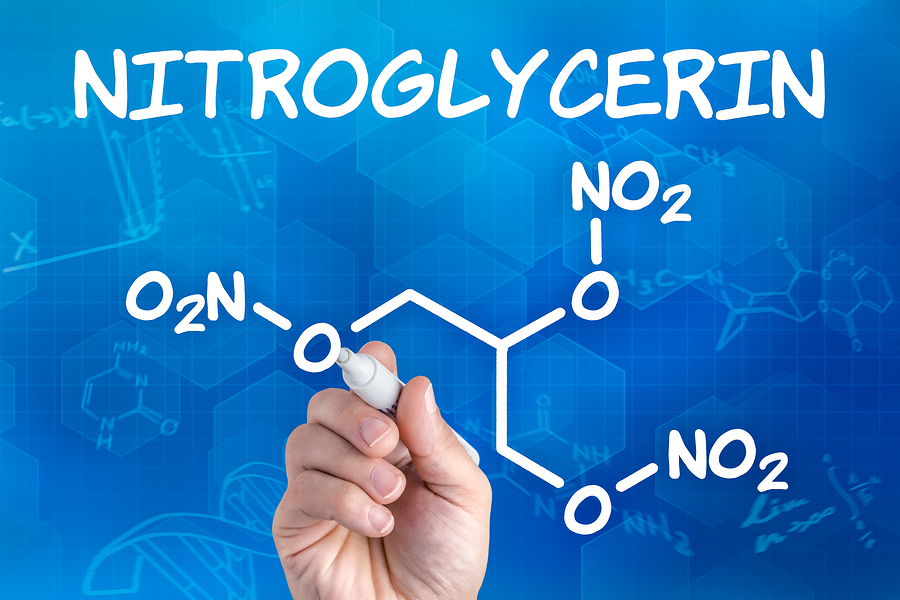Know Your Remedies: Glonoinum (Glon.)
 Common Names: Nitroglycerine.
Common Names: Nitroglycerine.
General Information
Nitrogylcerine is a highly volatile and reactive explosive. It was first discovered in 1847 but was quickly shelved following numerous deaths from its use. In the 1860s, once a way to stabilise it was discovered, it was reintroduced as dynamite. In 1879, nitroglycerine was first used by conventional (allopathic) doctors as a way to treat angina pectoris – chest pain from ischaemic heart disease. What was clear back then but little-known today is that it was only taken up conventionally because homeopathic doctors had been successfully using it successfully for chest pain for 30 years and patients were voting with their feet. History records that nitroglycerine was first proven (tested) for treatment by homeopaths in 1848, just one year after its discovery. This proving produced symptoms similar to those it subsequently treated. It was used by them for types of angina pectoris, congestive headaches, menopausal flushing, convulsions, surging of blood to head and heart, pulsations throughout the body, and sensitivity to heat. Today, both branches of medicine – conventional and homeopathic – still turn to nitroglycerine’s homeopathic effects. Conventional medicine uses it in material doses of tablets, sprays, ointments or patches under the generic name of glyceryl trinitrate (GTN) and numerous brand names such as Anginine, Isordil, and Nitromin. Homeopaths use it in the safer potentised form of Glonoinum for numerous symptoms apart from its heart-related effects.
Mental-Emotional
- Confusion in familiar places. “Lost in well-known places.”
- Fear of stroke (cerebrovascular accident).
Female
- Hot flushes. Menopausal flushes (flashes).
Head
- Waves of intense, bursting, pulsating headache. Holds the head to stop the pounding sensation.
- Headache pulsating between the temples.
- Headache with flushed face, reddened eyes, and pulsating carotids.
- Congestive, pulsating headache from sunstroke.
Heart and Circulation
- Violent and visible pulsation of the heart with throbbing carotids and a hot, flushed face.
- Pulsating carotids.
- Pulsations throughout the body. Pulsating pain.
- Types of angina.
Where do I find it?
Glonoinum (Glon.) is available from our online store as a single remedy in either pills or liquid, and as part of the following Complex (combination remedy): Hot Flushes (Flashes).
Home Treatment Guidelines
Acute, Self-Limiting Conditions
Conditions like colds or minor injuries, which are short-term and typically improve on their own, can be managed at home with homeopathy. However, in emergencies or if symptoms worsen, contact your healthcare provider.
Chronic Conditions
These home treatment instructions do not apply for ongoing issues, whether mentioned above or not, like persistent allergies or chronic pain. You should consult a qualified homeopath for a personalized treatment plan to achieve the best results with homeopathy for chronic conditions.
How to Take the Remedy for Acute Conditions
- Take one pill or five drops of the remedy. The frequency depends on symptom severity. As examples:
- For life-threatening symptoms, take every 1 minute and seek emergency help immediately.
- For mild symptoms, take every 4 hours.
- Stop taking the remedy once you feel better. Resume if symptoms return.
- If no improvement after four doses, choose a different remedy or consult a professional homeopath.
- For more details on dosing, refer to: How Often to Dose with a 30C Homeopathic remedy.
- For information on the different potencies, read: Guidelines on which potency to use
Additional Notes From Past Masters
Homeopathy is a 200-year-old system of medicine. Early homeopaths recorded detailed notes on how remedies worked, including initial tests, remedy relationships, and their experiences. These writings were shared to improve homeopathic practice and now offer fascinating insights into past uses of homeopathy. Here’s an example, edited and modernised for clarity, from Leaders In Homoeopathic Therapeutics (1898) by E. B. NASH M.D.:
Leaders In Homoeopathic Therapeutics by E. B. NASH M.D.
Glonoinum
Sudden local congestion, especially to head and chest; bursting headache rising up from neck, with great throbbing and sense of expansion as if to burst; cannot bear the least jar.
Can’t bear anything on the head, especially hat; or pressure as of a hat.
Over-heating in the sun, or sunstroke.
* * * * *
This is, in the first place, one of our great head remedies. It has intense pain in the head, with great throbbing and sensation of fullness and constriction of the vessels of the neck. There are so many symptoms attending this condition of congestion that it is not wise to try to give them all here.
I used, in my early practice, to carry a small vial of the 1st dilution in my case on purpose for those who were inclined to sneer at the young doctor and his sweet medicine, and many a disbeliever have I convinced, in about five or ten minutes, that there might be power in small doses of sweet medicine, by dropping on the tongue a drop of this preparation, for it seldom failed to produce its characteristic throbbing headache within that time.
One lady, not willing to acknowledge that it affected her, rose to leave the room, and fainted and would have fallen to the floor if I had not caught her. No one ever asked after that experiment for any more proof of the power of homeopathic medicine.
This throbbing headache, seeming to arise from the neck, is very characteristic, and the throbbing is not a mere sensation but is visible in the carotid arteries. The vessels are full to bursting, and if their walls were not healthy there is danger of apoplexy. No remedy equals this one for producing sudden and severe congestion of the head, and none can cure it quicker when indicated by the symptoms.
The remedies that stand nearest Glonoine in their effect on the head I believe to be Belladonna and Melilotus.
Belladonna and Glonoine both have the fullness, pain and throbbing, but that of Glonoine is more intense and sudden in its onset, and, on the other hand, subsides more rapidly when relieved. Again, Glonoine is better adapted to the first or congestive stage of inflammatory diseases of the brain, while Belladonna goes further and may still be the appropriate remedy after the inflammatory stage is fully initiated.
Belladonna is better by bending the head backward; Glonoine worse. Belladonna is made worse by having the head uncovered, and suffers from having the hair cut; Glonoine must have the head uncovered, can’t bear to wear his hat, or wants the hair cut. Belladonna is worse lying down, even if he keeps still; Glonoine, though sometimes worse after lying down, is also sometimes better when lying still.
One symptom very characteristic of Glonoine is that the patient carries the head very carefully, for the least jar or shaking of it greatly aggravates the pain. Another peculiar symptom is, it seems to the patient that there is not only throbbing, but there is an undulating sensation as if the brain were moving in waves synchronous with the pulse.
There is more disturbance of the heart action with Glonoine than with Belladonna, though both have it strongly. Glonoine has a sensation of rush of blood to the heart or chest.
Melilotus also has great congestion to the head, with pain and sense of fullness. Not being so thoroughly proven as Belladonna and Glonoine, we cannot so clearly indicate the exact place for it, but there is one very prominent symptom which always makes one think of it, viz.: “Glowing redness of the face.” No remedy that I know of has it more strongly. Glonoine and Belladonna may both have very red face; on the other hand, a pale face, with the other congestive symptoms, does not contraindicate them, but does Melilotus.
Then, again, with Melilotus the head symptoms are often relieved by a profuse epistaxis, which is also another very prominent symptom of this remedy. I cured a very bad case of typhus cerebralis, and also a case of insanity of long standing, with this remedy, being guided to it by these symptoms.
“Loses his way in well-known streets” is a symptom of Glonoine that has several times been confirmed.
The local congestions of Glonoine are often found in different diseases; for instance, climacteric flushings are often most felt in the head. Glonoine cures such cases.
It is also useful in puerperal convulsions. And another symptom often present in these cases is, a sense as if the head were expanding from fullness. Now look out for convulsions and give Glonoine, especially if there be albumen in the urine.
Congestion to the head from suppressed or retarded menses sometimes finds a remedy here; also, different pathological conditions of the heart, but the symptoms must be present.
For sunstroke it is probably oftener indicated than any other remedy; also for the after-sufferings therefrom. Not only from sunstroke, but from other bad effects of radiate heat; for instance, children get sick in the night after sitting too long or falling asleep before an open coal fire.
Then, again, warm room increases the headache and warm bed the face ache.
“Burning between the shoulders” is another symptom of this remedy, like Lycopodium and Phosphorus. Ammonium muriaticum and Lachnanthes have the opposite.
While we are here now I will call attention to another remedy, which, for flushings and congestions to head and face, resembles Glonoine, that is, Amyl. nit.




